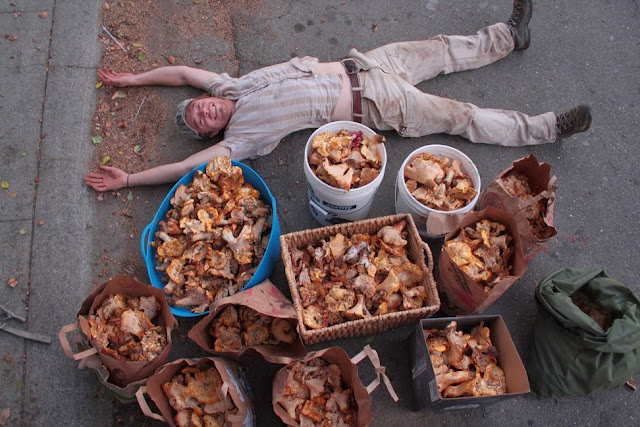I've been in the Bahamas for the last two weeks, studying the effect of resource pulses (hurricane-wrecked seaweed) on island communities with
this project. In doing so, we kept coming upon these strange shelters on wild guava (Psidium longipes), locally called Bahama stopper, since the hard wooded bush/tree would apparently stop any progress you try to make into the thick coppice.
 |
| What on earth is this? ~ 4 cm tall (pretty damn big by insect standards). |
Inside some of these shelters (2/13), there was an odd larva, apparently a beetle larva, or so I initially thought. Because I am mostly a caterpillar person, I didn't really pay it much mind.
 |
| A really terrible picture, but notice the "antennae". About 2-3 cm long. |
Louie, while processing insect samples one night, noticed that some things were not right about the apparent beetle larva - namely it had prolegs, the fleshy appendages that give caterpillars the appearance of having more than the six legs all insects have. I then looked at the "antennae" and found that they were not segmented, a dead giveaway that this was, in fact, a caterpillar and the "antennae" were actually tentacles (yes, that is the technical term for the fleshy projections that many caterpillars have -
monarchs for instance).
 |
Several of the shelters were torn like this, suggesting predation (by a bird [?]). This was the
only shelter with lines affixing it at the top - many had lower lines. |
I got much more interested after that, and sent along these pictures to
Charley Eisemann, a good friend and probably the person on earth with the most knowledge about insect shelters. His blog - linked above - is simply phenomenal and if anyone was going to know the answer, he would. Very quickly (within a few minutes), he had correctly found the family of the moth - Mimallonidae. The amazing part here is that Charley has never seen a member of this family! Mimallonidae is an extremely small family by Lepidoptera standards, ~200 spp. - only 3 of which occur regularly in the US, a fourth is described from the US in Brownsville, TX, but is probably a tropical stray. He even dug pretty deep and found a very likely species identity,
Ciccinus packardii - known from Cuba and known to feed on other
Psidium species. While I do not know this for sure, it seems that is the most likely candidate as the larva matches very well the few images of Ciccinus online, and less so the other mimallonid genera.
After a bit more searching, we came upon a young larvae feeding in a leaf press on
P. longipes, which was not what I expected. This family is known as the "sack-bearers" and I was expecting something more along the lines of a bagworm (Psychidae), instead of a leaf presser.
 |
| A young (2nd, 3rd instar?) larva of this Ciccinus sp. ~ 8mm |
Which brings us to the strange, pitcher plant-like shelters. The larva is oriented vertically inside the shelter, with a strange butt plate plugging up the bottom hole and the head just below the upper hole. What function the little hood forms is mysterious - perhaps shading the larva from the hot Bahamian sun or fierce rains? The better-known
Ciccinus species of the US,
C. melshiemeri, feeds on old oak leaves (too tannic for most caterpillars) and constructs a shelter, sort of like the pictured ones of frass pellets, silk and oak leaves in which it spends the winter as a larva, prior to pupation in the spring. This seems to be the case for this species as well - in two cases, I found spent pupal skins.
 |
Spent pupal skin (successful emergence!) inside one of the shelters. You can also see the construction of silk and what
appears to be finely ground frass (caterpillar poop - a common building material for cats). |
Interestingly, I did find one that fit the description of the
C. melshiemeri shelters well.
 |
| This was the only shelter anchored into leaves (it was vacant, unfortunately). You can see well the frass pellets forming the top of the shelter here. |
 |
| The same shelter, with a Psidium leaf forming one side. |
These guys kept me occupied for quite awhile (I even dreamt about them!) and seem like a worthy avenue for future rearing efforts... there are a great deal of questions that remain about the shelters: Why the strange shape with a hood? Why build a free standing shelter, as opposed to anchoring it to a stem like most moths? Why wait around in a shelter instead of pupating right away? Do the shelters protect inhabitants from predators and parasitoids?
 |
| perhaps the prettiest of all found. I like the subtle banding. |
Many thanks to Charley, Julia Blyth, John De Benedictus, Louie Yang, Jonah Piova-Scott and Jenn Mckenzie (who was the only one that could find occupied shelters) for help with the identification and finding of these guys.

































